Family: Rosaceae
The cherries can be divided into three groups: the European, the American, and the Oriental. In general, the Oriental types are less hardy. This genus comprises over 400 species and numerous cultivars of trees and shrubs growing in temperate climates-mostly in the Northern Hemisphere. It includes evergreen shrubs, flowering fruit trees, and all the stone fruits – almonds, apricots, cherries, nectarines, peaches, plums, and prunes. They are also highly ornamental.
Reed has more than 70 cherry trees that fill the campus with flowers in the spring.
Cherry Plum
Scientific name: Prunus cerasifera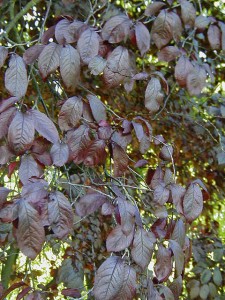
 This is an ancient Eurasian hybrid, known only in cultivation. It comes in several forms, with flowers varying from white to pink, and leaves varying from green to purple. This tree can eventually reach 50 feet in height.
`Thundercloud' - This tree is a cultivar of the cherry plum. It is a small tree at maturity with coppery leaves and a mass of light pink blossoms in late winter or early spring.
This is an ancient Eurasian hybrid, known only in cultivation. It comes in several forms, with flowers varying from white to pink, and leaves varying from green to purple. This tree can eventually reach 50 feet in height.
`Thundercloud' - This tree is a cultivar of the cherry plum. It is a small tree at maturity with coppery leaves and a mass of light pink blossoms in late winter or early spring.
View tree page and map.Domestic Plum
Scientific name: Prunus domestica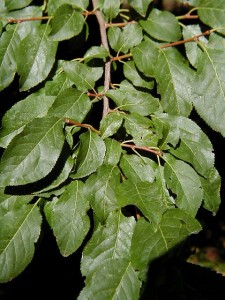
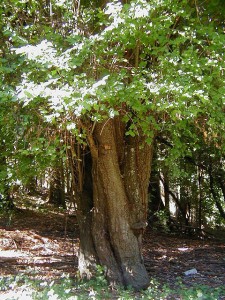 This species originated in southwestern Asia, although it quickly naturalized in North America. There are many cultivars for orchard use and they produce plums of various colors. The original color of the fruit is gold-yellow.
This species originated in southwestern Asia, although it quickly naturalized in North America. There are many cultivars for orchard use and they produce plums of various colors. The original color of the fruit is gold-yellow.
View tree page and map.European Bird Cherry
Scientific name: Prunus padus
 Also called Mayday tree or Maybush, this tree has a moderate growth rate to 15-20 feet. Dull green, oval leaves appear early in spring. Small, white flowers in late April or early May are what make this tree attractive. It is widely planted as a street tree in Portland.
Also called Mayday tree or Maybush, this tree has a moderate growth rate to 15-20 feet. Dull green, oval leaves appear early in spring. Small, white flowers in late April or early May are what make this tree attractive. It is widely planted as a street tree in Portland.
View tree page and map.Japanese Flowering Cherry
Scientific name: Prunus serrulata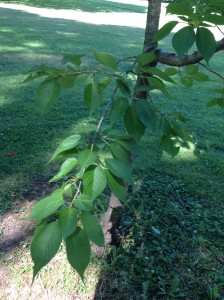
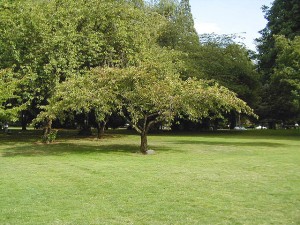 This cherry had over 120 cultivars, which are usually grafted onto Prunus avium stock (evident by a bulge with several limbs coming out at the same point). Many of the cultivars originated many years ago in Japan.
'Akebono' - In 1920 the W. B. Clarke & Co. nursery in San Jose, California, introduced a new seedling called 'Akebono', which has had wide distribution and is very popular. As Japanese Flowering Cherries go, the Akebono can become quite large. Its blossoms are a delicate pink color; they make the tree look like a cloud in the spring.
'Kwanzan' - The Kwanzan Cherry is ornamental, producing large, double, rosy-pink, pendant clusters of blooms. It is planted along many of Portland's streets.
'Shirotae' - This beautiful, spreading cherry with fragrant, snow white flowers is also called `Mt. Fuji.' It is easy to spot at any time of the year because of its low horizontal growth pattern.
This cherry had over 120 cultivars, which are usually grafted onto Prunus avium stock (evident by a bulge with several limbs coming out at the same point). Many of the cultivars originated many years ago in Japan.
'Akebono' - In 1920 the W. B. Clarke & Co. nursery in San Jose, California, introduced a new seedling called 'Akebono', which has had wide distribution and is very popular. As Japanese Flowering Cherries go, the Akebono can become quite large. Its blossoms are a delicate pink color; they make the tree look like a cloud in the spring.
'Kwanzan' - The Kwanzan Cherry is ornamental, producing large, double, rosy-pink, pendant clusters of blooms. It is planted along many of Portland's streets.
'Shirotae' - This beautiful, spreading cherry with fragrant, snow white flowers is also called `Mt. Fuji.' It is easy to spot at any time of the year because of its low horizontal growth pattern.
View tree page and map.Schubert Choke Cherry
Scientific name: Prunus virginiana `Schubert'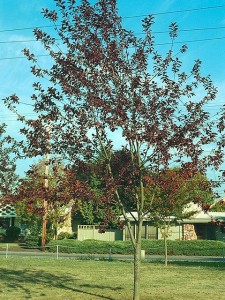 A small tree with tiny white blossoms in the spring, this cultivar produces leaves that open green, then turn red as they mature. The tree tends to sucker.
A small tree with tiny white blossoms in the spring, this cultivar produces leaves that open green, then turn red as they mature. The tree tends to sucker.
View tree page and map.Sweet Cherry
Scientific name: Prunus aviumAlso known as the Mazzard cherry, this deciduous tree is native to Europe and Asia. Blossoms are white and the bark is a red mahogany. It has been cultivated since ancient times and is the source from which our present-day eating cherries are derived.
View tree page and map.Weeping Japanese Cherry
Scientific name: Prunus subhirtella `Pendula'
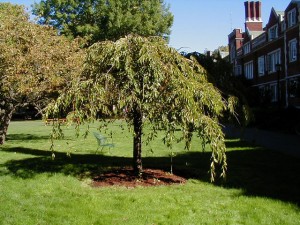 This tree was introduced to this country from Japan in 1894, and it has since become popular. In Japan it is long-lived: one is 1,000 years old and measures 32 feet in circumference.
This tree was introduced to this country from Japan in 1894, and it has since become popular. In Japan it is long-lived: one is 1,000 years old and measures 32 feet in circumference.
View tree page and map.Yoshino Flowering Cherry
Scientific name: Prunus x yedoensis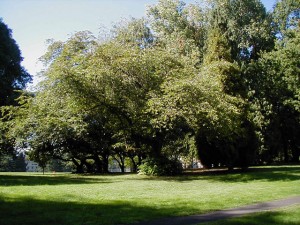 A beautiful flowering cherry with fragrant white or pale pink blossoms, the Yoshino Cherry is often found in Japanese gardens, and it is the main cherry tree seen in Washington, D.C. It is a rather late bloomer: late March to early April.
A beautiful flowering cherry with fragrant white or pale pink blossoms, the Yoshino Cherry is often found in Japanese gardens, and it is the main cherry tree seen in Washington, D.C. It is a rather late bloomer: late March to early April.
View tree page and map.
Pingback: Cherry Blossoms in Portland: The Top 2 Spots – Adventures with Holly & Bryan